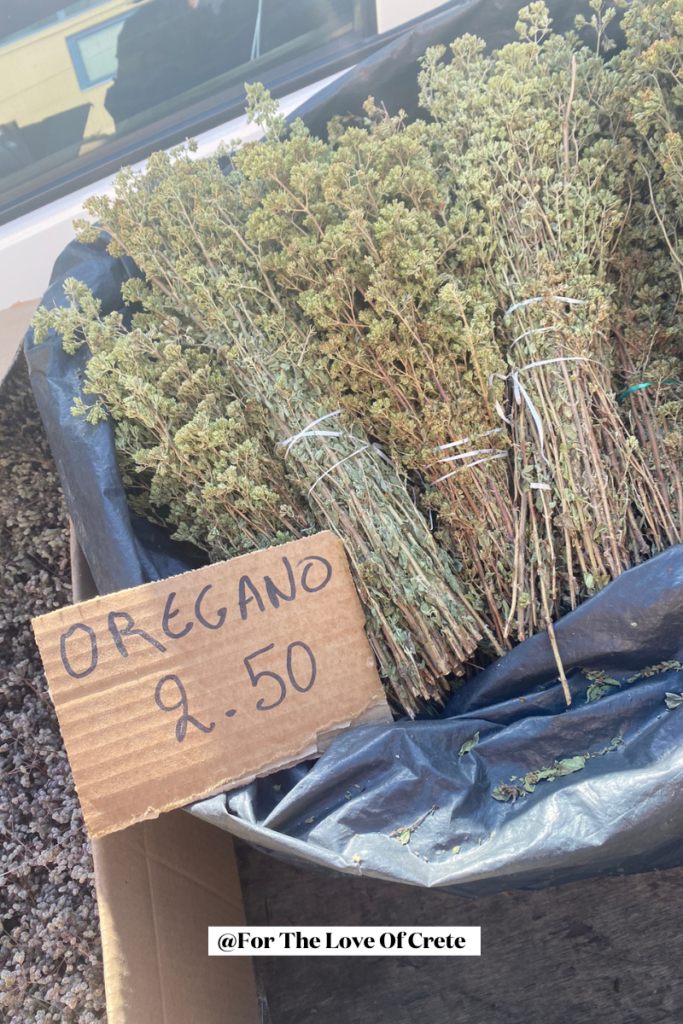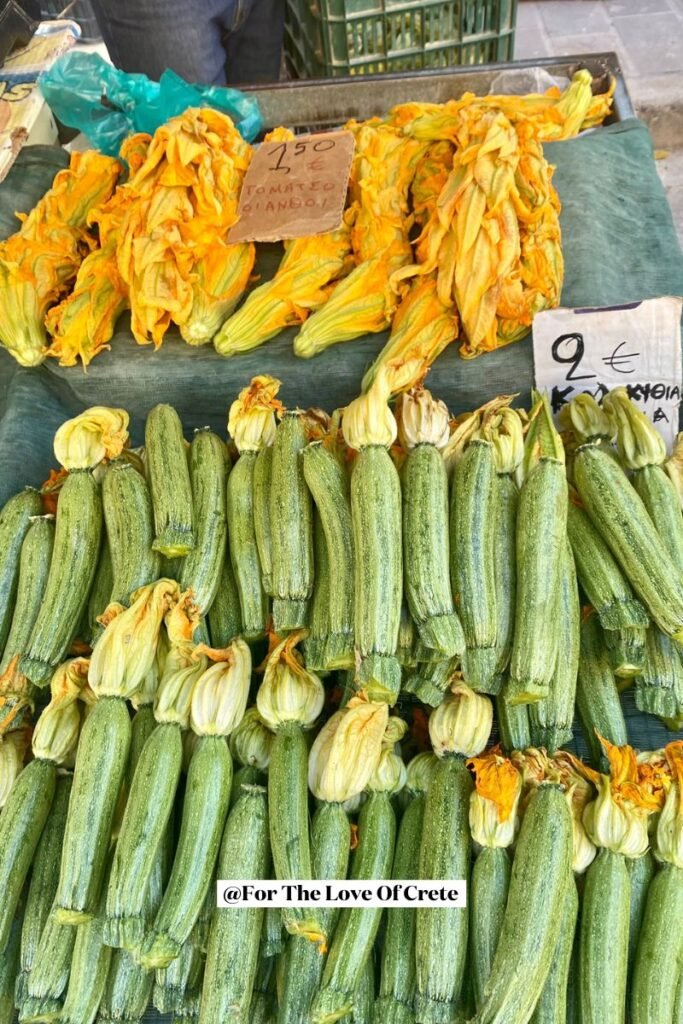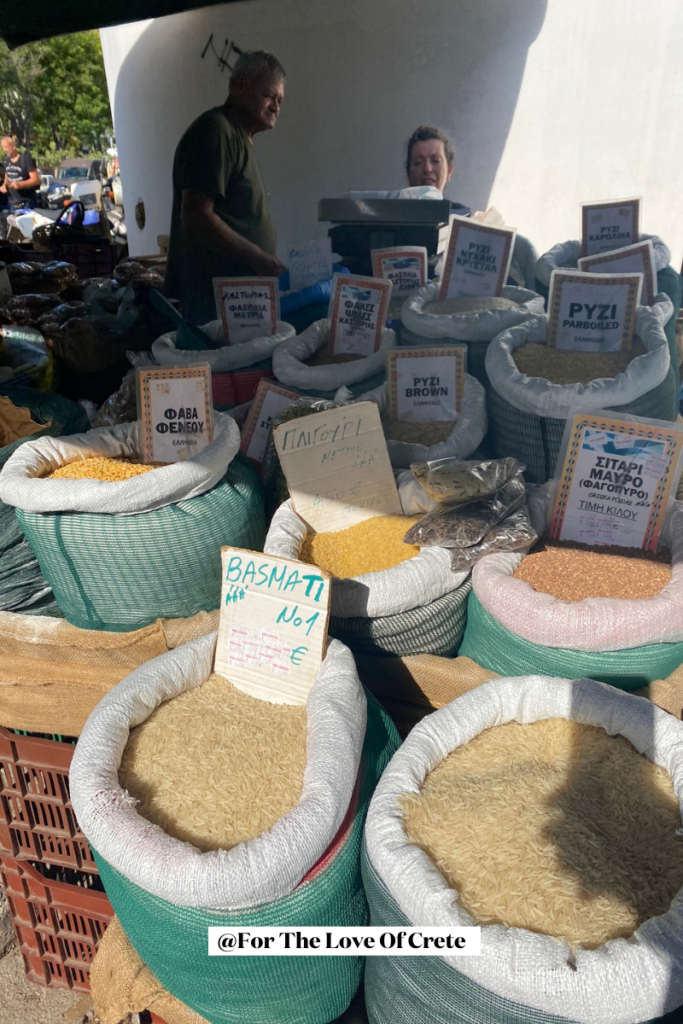As you step into Chania’s traditional market on Minoos Street, known in Greek as “λαϊκή αγορά” (laiki agora) or simply “λαϊκή” (laiki), you’re instantly transported to the heart of Cretan culture. The vibrant colors, enticing aromas, and lively chatter of vendors and shoppers alike create an atmosphere that’s both invigorating and nostalgic. You’ll find yourself drawn to stalls overflowing with sun-kissed produce, artisanal cheeses, and fragrant herbs that tell the story of Crete’s rich culinary heritage.

But this market offers more than just a feast for the senses; it’s a gateway to understanding the island’s traditions, its people, and the secrets behind its world-renowned cuisine. Indeed, the very name “λαϊκή αγορά” (laiki agora), which translates to “people’s market” or “folk market,” reflects its true essence.
Here, in this bustling marketplace, you’ll experience firsthand the beating heart of Cretan life, where the island’s culture, traditions, and the warmth of its people converge in a vibrant tapestry of sights, sounds, and flavors.
History of the Markets in Crete

Where did Crete’s vibrant open markets originate? The roots of these lively gatherings stretch back to ancient times when Minoan civilization thrived on the island. You’d find that these markets have been a cornerstone of Cretan life for millennia, evolving from simple trade centers to the bustling hubs of community interaction you see today.

In medieval times, under Venetian rule, the markets grew in importance. You’d have seen them expand beyond mere commerce, becoming vital spaces for social and cultural exchange.
The Ottoman period further enriched this tradition, introducing new flavors and goods from the East.

As you walk through today’s markets, you’re part of a living history that’s weathered countless changes. The resilience of these markets through various occupations and conflicts speaks to their significance in Cretan identity. They’ve adapted, but never lost their essence as the beating heart of local communities.
You’re not just shopping when you visit; you’re participating in a tradition that’s shaped Cretan society for generations. It’s a place where you’ll feel connected to the island’s past and present.
Introducing the Open Market at Minoos Street in Chania

Nestled along the western fortification wall of Chania, the open market on Minoos Street bursts with life every Saturday morning. As you stroll through this vibrant marketplace, you’ll find yourself immersed in the heart of Cretan culture. This isn’t a tourist attraction; it’s where locals gather to do their weekly shopping and catch up with neighbors.

You’ll be greeted by an array of colorful stalls offering fresh produce, local honey, herbs, olive oil, and cheeses. The market’s authentic atmosphere invites you to engage with friendly vendors who take pride in their products. Don’t be surprised if you’re offered samples – it’s all part of the experience.
As you venture deeper into the market, you’ll discover a section dedicated to clothing and other goods. Here, you can grab some nice bargains on linen and cotton pieces, perfect for the Cretan climate and as souvenirs to take home.

The lively buzz of conversations in Greek adds to the charm, making you feel like a part of the community. Whether you’re practicing your Greek or simply soaking in the ambiance, you’ll find yourself connecting with the warm spirit of Crete at every turn.
Local Cretan Produce Highlights

As you explore the stalls, you’ll quickly notice the abundance of fresh, locally grown produce that defines Cretan cuisine. You’ll find yourself surrounded by vibrant displays of sun-ripened tomatoes, crisp cucumbers, and fragrant herbs like oregano and thyme. Don’t miss the opportunity to sample the renowned Cretan olive oil, known for its rich flavor and health benefits.

You’ll be drawn to the array of local cheeses, including the famous graviera and mizithra. The honey selection is equally impressive, with varieties ranging from thyme to pine honey. Each jar tells a story of Crete’s diverse landscapes and hardworking beekeepers. You can even find propolis and other beeswax-based creams, as well as tinctures and infused oils such as St John’s Wort Oil, known for its potential benefits in treating mild depression and skin conditions.

As you browse, you’ll encounter unique Cretan specialties like carob products, rusks, and wild greens. The vendors are always eager to share recipes and cooking tips, making you feel like part of the local community.
Remember to keep an eye out for seasonal treats. Depending on the time of year, you might find succulent figs, juicy pomegranates, or sweet watermelons. By embracing these local flavors, you’re not just shopping – you’re immersing yourself in Cretan culture and supporting local farmers.

A personal recommendation: don’t miss the Greek oregano at this market. It’s possibly the best you’ll ever taste – incredibly fragrant and wild-harvested, a world apart from the GMO or imported varieties you might find elsewhere.
Cretan Cheese and Dairy
A cheese lover’s paradise awaits you at Chania’s traditional market. As you wander through the bustling stalls, you’ll discover an array of Cretan cheeses that’ll tantalize your taste buds and immerse you in local culture.

Don’t miss the opportunity to sample graviera, Crete’s beloved hard cheese. Its nutty flavor and slightly sweet undertones will transport you to the island’s sun-drenched pastures. You’ll also find mizithra, a soft, fresh cheese made from sheep’s or goat’s milk. It’s perfect for spreading on crusty bread or crumbling over salads.

For a truly authentic experience, try anthotyros, a whey cheese with a delicate flavor that pairs wonderfully with local honey. And if you’re feeling adventurous, ask for ksinomizithra, a tangy, aged version of mizithra that’ll add a zesty kick to your dishes.
You can also buy the Greek P.D.O. Feta here, and I promise you, the feta you buy from any store in Western Europe will never match the depth of taste of the feta you will taste in Crete.

As you chat with the friendly vendors, you’ll learn about traditional cheese-making methods passed down through generations. They’ll eagerly share stories about their family farms and offer tips on how to best enjoy their products. By the time you leave, you’ll feel like part of the Cretan cheese-making family.
Spices and Herbs Galore
The market’s aromatic symphony hits you as you approach the spice and herb stalls. You’re instantly enveloped in a cloud of fragrant scents, each one telling a story of Cretan culinary tradition. As you wander through, you’ll find yourself among fellow food lovers, all seeking to enhance their dishes with these local treasures.

You’ll spot familiar favorites like oregano, thyme, and rosemary, but don’t miss out on uniquely Cretan herbs like dittany and malotira. These native plants have been used for centuries in local cuisine and traditional medicine. Vendors are happy to share their knowledge, offering tips on how to use each herb in your cooking.
The spice selection is equally impressive. You’ll find vibrant saffron threads, aromatic cumin seeds, and fiery chili flakes. Don’t hesitate to ask for a small sample – the vendors are proud of their products and eager to let you experience the flavors firsthand.

As you browse, you’ll feel a connection to the island’s rich culinary heritage. These spices and herbs are more than just seasonings; they’re a vital part of Cretan culture, linking you to generations of island cooks.
Buying herbs and spices to cook with at home is like taking the smell and taste of Crete with you. Every time you cook with these spices or infuse a Cretan herb in tea, you’ll bring the essence of Crete back to life in your own kitchen.

Culinary Traditions and Recipes
Countless culinary traditions and recipes are woven into the fabric of Cretan culture, and you’ll find their essence at Chania’s traditional market. As you wander through the different vendors, you’ll discover the building blocks of authentic Cretan cuisine. Don’t be shy about asking vendors for cooking tips – they’re often eager to share their family recipes and time-honored techniques.

You’ll notice the prevalence of olive oil, a cornerstone of the Cretan diet. Learn how locals use it in everything from savory dishes to sweet treats. Look out for dakos, a popular meze made with barley rusks, tomatoes, and mizithra cheese. You’ll also find ingredients for kalitsounia, small cheese pies that are a local favorite.

You’ll usually find a vendor or two with a large selection of different olives. You might see varieties like Kalamata or Amfissa, but don’t miss the chance to try a distinctly Cretan variety called alotsòlies. These olives look like dehydrated raisins and have a unique, intense flavor that sets them apart from other Greek olives. (Fun fact: Their resemblance to raisins has led to some amusing mix-ups for unsuspecting visitors!)
The market is your gateway to understanding Cretan food culture. You’ll see how seasonality plays a crucial role in the local diet, with different produce taking center stage throughout the year.
Meeting the Market Vendors

While exploring Chania’s culinary traditions, you’ll naturally find yourself interacting with the market’s vibrant cast of characters. These vendors aren’t just sellers; they’re the guardians of Cretan culture and cuisine. As you wander through the stalls, you’ll encounter friendly faces eager to share their passion for local produce.

Don’t be shy to strike up a conversation. Even if your Greek is limited, most vendors appreciate your effort to connect. They’ll patiently explain the origins of their goods, from the honey harvested in nearby mountains to the cheese crafted in family-run dairies.

Look out for the older vendors, whose weathered hands tell stories of a lifetime tending olive groves or beehives. They’re often the most enthusiastic about sharing their knowledge. You’ll discover that many of these families have been selling at the market for generations, passing down their expertise and love for Cretan produce.

Tips for The Best Experience
To make the most of your visit to Chania’s traditional market, keep these essential tips in mind. Arrive early, around 7 AM when the market opens, to experience the bustling atmosphere and secure the freshest produce. Bring your own shopping bags to carry your purchases and blend in with the locals. Don’t be afraid to try your hand at speaking Greek, even if it’s just a few simple phrases – the vendors will appreciate your effort.

Come prepared with cash, as most stalls don’t accept cards. Be open to tasting samples offered by vendors; it’s considered polite and helps you discover new flavors. Dress comfortably and wear sturdy shoes, as you may be walking on uneven surfaces. Learn some basic Greek words for common items like fruits, vegetables, and cheese to navigate the market more easily.

Embrace the local culture by taking your time, chatting with vendors, and asking about their products. Remember, this is primarily a market for locals, so respect their space and traditions.
Conclusion
As you leave Chania’s traditional market, your senses still alive with the colors, scents, and flavors of Crete, you’ll realize you’ve experienced something truly special. This isn’t just a place to shop; it’s a living, breathing piece of Cretan culture. You’ve tasted the island’s bounty, from sun-ripened tomatoes to wild oregano that puts all others to shame. You’ve interacted with vendors whose families have been part of this tradition for generations, each conversation enriching your understanding of Cretan life.

But perhaps most importantly, you’ve played a part in supporting the small, family-run businesses that are the backbone of this community. Each purchase, each smile exchanged, each heartfelt “efharistó” (thank you) you’ve received has been a meaningful connection to the people who make Crete what it is.

As you unpack your treasures at home – perhaps a bag of aromatic herbs, a chunk of tangy feta, or a bottle of golden olive oil – you’ll find you’ve brought a piece of Crete back with you. These flavors will transport you back to the bustling market whenever you use them, keeping the spirit of Chania alive in your own kitchen.

So cherish these memories, these tastes, these connections. They’re not just souvenirs; they’re a part of Crete’s story, and now, they’re a part of yours too. And remember, the market will be there, just as vibrant and welcoming, when you return to Chania, ready to write the next chapter in your Cretan adventure.











